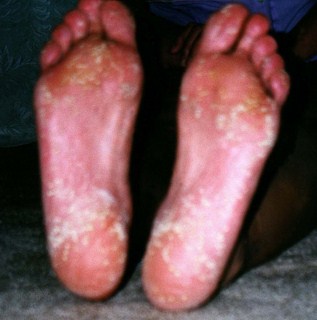Porokeratosis – Treatment, Pictures, Definition, Symptoms, Causes
What is Porokeratosis?
Many persons report that they have growth found on the bottom of the foot which is painful. Although some of this may be associated with other disorder such as calluses. Another cause of this painful growth, which is described as somewhat like having a stone in their own shoes, is medically termed as porokeratosis. It has many names which may be associated with this kind of disease condition.
Such of the names are senile keratosis, senile wards, basal cell papilloma, seborrheic veruca, brown warts and barnacles. In addition to that, it is known to be a class of disorders that fall under dyskeratotic classification. It has a characteristic of atrophic patches that has a threadlike-ring that surrounds it. Other experts would say that it is a kind of skin condition that is known in adults, which is mostly reported on women which are around 30-40 years of age.
However, some will manifest the disease at the earliest, which is in his or her childhood years. It is a general medical term which occurs elsewhere in the person’s body but it is commonly reported to be seen most often in the patient’s foot.

Plaques and lesions found at foot of the patient who has Porokeratosis
Porokeratosis Symptoms
Persons who have porokeratosis will manifest the following symptoms:
- Discolored specks or patches
- Warty rim which is located around the edge
- Having boundaries that are irregular
- Scaly papules which are light brown in hue
- Itchy
- Lesions
- Plaques
Studies show that porokeratosis has a higher chance of developing into skin cancer if not treated immediately. Hence, if you have felt any sore or lump in the lesion of your porokeratosis then you have to consult and see a physician preferably someone who specializes in the skin or dermatologist to get it check immediately.

Discolored specks or patches found at legs
Porokeratosis Causes
Prior to the known of this disease condition, some experts believed that this kind of disease condition is genetic in nature. However, with more studies conducted, some persons who doesn’t have the genes for this kind of disease also acquired the disease condition. So basically, anyone can be at risk for this kind of disease condition. Still further studies have pointed out the exact cause of why persons have the disease condition primarily because of:
- Immunosuppressant
- Therapeutic phototherapy
- Too much sun exposure
- Ultraviolet light exposure
- Radiation therapy
- Genetic
- Aside from that, renal transplant patient also develop this skin condition in the later parts of their disease. Hence, they are at high risk for this disease condition.
Porokeratosis Treatment
As mandated, the treatment for porokeratosis is individualized. The treatment that is undergone by one patient to another varies. Yet, those who are in the noncancerous type of porokeratosis are not suggested to undergo aggressive kind of treatment. Instead, they are suggested to have at least once in a year checkups or consultations of their physicians to detect the presence of any growth that is considered abnormal in nature. The treatment commonly suggested may be as follows:
- Using of protective clothing and sunscreen whenever one goes outdoors heedless of the weather
- Pharmacological medication under which are often prescribed to patients are:
- 5-fluorouracil in topical cream form which improves the appearance of the lesion.
- Vitamin D-3 analogues also in topical form wherein effective results can be seen within 3-6 months of usage.
- Immunomodulators such as imiquimod 5% cream which is also in topical form are effective for classic type of porokeratosis.
- Retinoids in oral form which reduces cancer formation risk.
Surgical Care Treatment
It is mostly suggested to patients who have malignant form of the porokeratosis lesions. Such surgical procedure may be done:
- Electrodesiccation and curretage
- Diamond fraise dermabrasion
- Cryotherapy
- Laser therapy surgical treatment such as carbon dioxide laser ablation may be performed
- Photodynamic therapy
- Ultrasonic surgical type of aspiration
- Excision
Amongst the surgical intervention mentioned, the excision is often the widely used. However, the kind of surgical intervention or procedure will greatly depend on the assessment done by the physician and the extent of the malignancy is present. Some physician would suggest, for patients with malignant cases, to have chemotherapy and surgery combined to have a reduce risk of health problems.